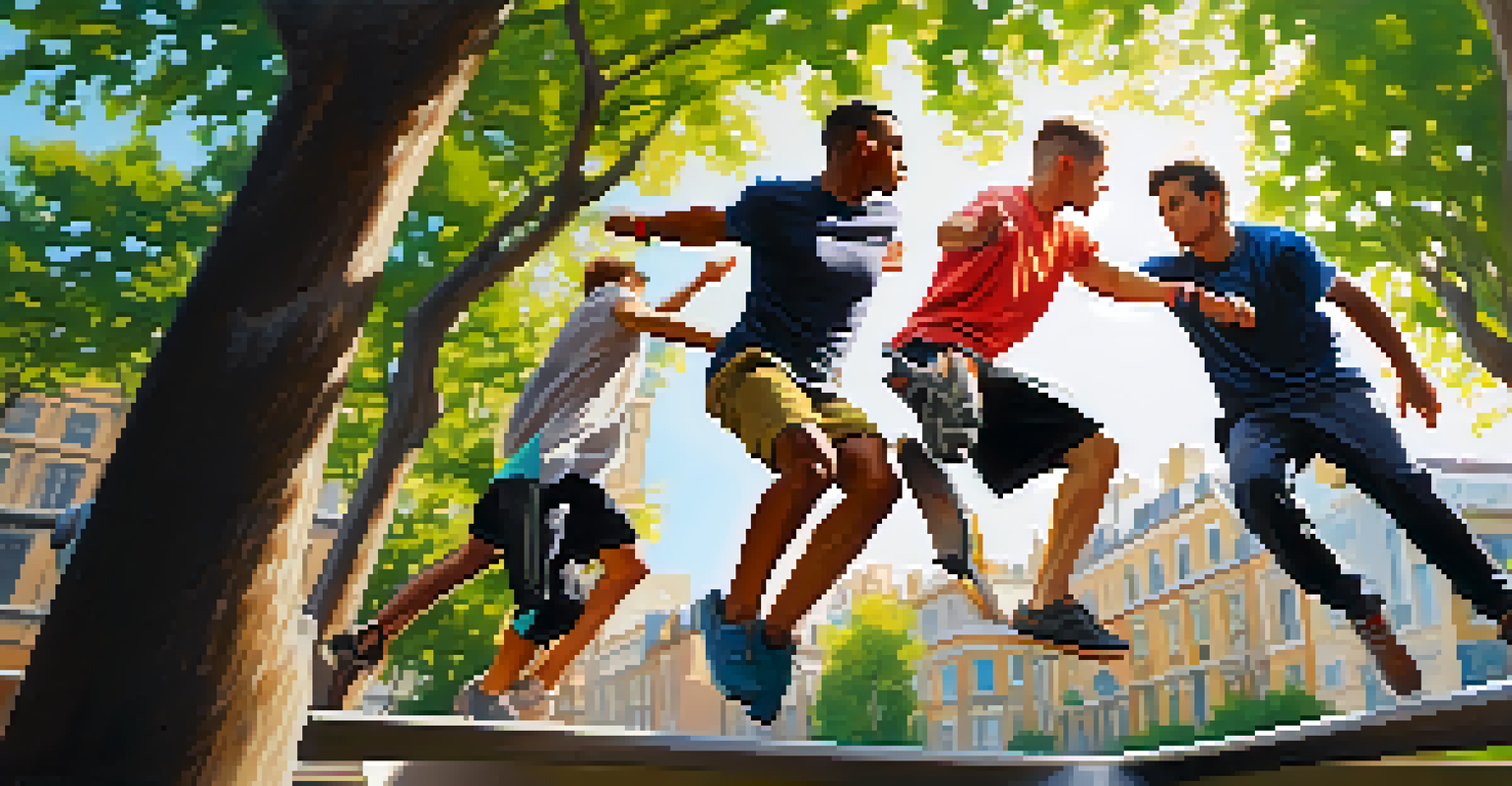The Science of Movement: Physics Behind Parkour Techniques

Understanding Parkour: More Than Just a Sport
Parkour is often perceived as a thrilling sport, but at its core, it's a discipline that combines physical fitness with mental agility. Practitioners, known as traceurs, navigate urban landscapes by jumping, climbing, and rolling. This dance of movement is not just about the physical act; it's about overcoming obstacles and pushing personal limits. The beauty of parkour lies in its ability to transform ordinary environments into playgrounds for creativity and expression.
The human body is capable of amazing things, but it takes practice to harness that potential.
In essence, parkour challenges our understanding of physics and movement. When a traceur vaults over a wall or leaps from one rooftop to another, they are not just showcasing athleticism; they are engaging with the principles of force, gravity, and momentum. Each movement is a calculated risk, blending art with science. This interplay between creativity and physics is what makes parkour so fascinating and engaging.
As we delve deeper into the science behind parkour, we begin to appreciate the underlying principles that govern these incredible feats. Each jump and roll can be analyzed through the lens of physics, revealing the intricate relationship between the human body and the forces of nature. Understanding this connection not only enhances our appreciation for the sport but also inspires us to push our own boundaries.
The Role of Gravity in Parkour Movements
Gravity is the invisible force that pulls us toward the Earth, and it plays a central role in every parkour move. When a traceur leaps into the air, they must negotiate the pull of gravity while maximizing their height and distance. Understanding how to manipulate this force allows practitioners to execute jumps with more precision and control. This is why parkour emphasizes proper body positioning and technique during takeoff and landing.

For instance, when a traceur jumps off a ledge, they must account for the gravitational pull that will affect their descent. The angle of their jump, the speed of their approach, and the timing of their landing all contribute to a successful maneuver. By mastering the physics of gravity, traceurs can perform seemingly impossible feats while minimizing the risk of injury. This understanding of gravity transforms their movements from mere stunts into calculated expressions of skill.
Parkour Blends Art and Science
Parkour combines physical fitness and mental agility, transforming urban environments into creative playgrounds.
Moreover, gravity also influences how traceurs absorb the impact when landing. Techniques such as rolling help dissipate the force, allowing them to transition smoothly into their next movement. This knowledge not only aids in performance but also enhances safety, making gravity both a challenge and an ally in the world of parkour.
Momentum: The Key to Efficient Movement
Momentum, or the quantity of motion an object possesses, is crucial in parkour. When a traceur runs and jumps, they carry forward the momentum generated by their speed, which can make a significant difference in their ability to clear obstacles. The faster they move, the more momentum they have, allowing them to leap further and land more effectively. This principle is a vital part of mastering parkour techniques.
Movement is a celebration of the body’s abilities, a dance of physics and creativity.
Take, for example, the precision jump—a common move in parkour. By generating momentum through a running start, a traceur can launch themselves toward a target with greater accuracy. This not only increases the likelihood of success but also enhances their overall flow from one movement to the next. The ability to maintain momentum throughout a sequence of moves is what separates skilled traceurs from beginners.
To maximize momentum, traceurs also focus on their body mechanics, utilizing their arms to propel themselves and adjust their trajectory. This awareness of momentum allows them to navigate complex environments with agility and confidence. Ultimately, understanding and harnessing momentum is essential for any aspiring parkour athlete.
The Importance of Force in Parkour Techniques
Force is a fundamental concept in physics that plays a vital role in parkour. It is the push or pull that causes an object to move or change direction. When a traceur performs a jump, they exert force against the ground, propelling themselves into the air. The amount of force applied is directly related to the height and distance of their jump, making it a critical factor in executing various techniques.
For instance, during a vault, a traceur must apply sufficient force to lift their body over an obstacle. This requires not only strength but also precise timing and technique to ensure that the force is directed appropriately. By understanding the relationship between force and movement, traceurs can refine their skills and enhance their performance.
Gravity Influences Every Move
Understanding gravity helps traceurs execute jumps with precision while minimizing injury risk.
Additionally, force plays a significant role in landing safely. A traceur must absorb the impact of their landing by bending their knees and utilizing their core strength, effectively managing the force exerted on their body. This understanding of force not only improves performance but also reduces the risk of injury, highlighting the importance of physics in parkour.
Analyzing Trajectories: The Path of a Parkour Move
Every parkour move follows a specific trajectory, which is the path taken by a moving object. When a traceur leaps or rolls, understanding their trajectory is essential for landing safely and accurately. The angle of takeoff, speed, and initial height all influence the trajectory of the jump, making it a vital component of parkour techniques. This awareness allows practitioners to execute their moves with precision.
For example, when performing a wall run, a traceur must calculate the optimal angle to launch themselves off the wall. A steep angle may lead to a shorter jump, while a flatter angle could allow for greater distance. By analyzing these trajectories, traceurs can adjust their approach and refine their techniques, enhancing their overall efficiency in navigating obstacles.
Moreover, understanding trajectory can also help traceurs anticipate their landing spots, increasing their confidence during complex sequences. This knowledge empowers them to push their limits while minimizing risks, transforming the art of parkour into a science of movement.
The Role of Balance and Stability in Parkour
Balance and stability are crucial components of successful parkour techniques. As traceurs navigate their environment, they must maintain equilibrium while executing complex movements. This ability to balance allows them to perform feats like landing on narrow ledges or transitioning smoothly between obstacles. Developing balance is essential for every parkour athlete.
One way to enhance balance is through training that focuses on core strength and body awareness. A strong core helps stabilize the body during jumps and landings, providing the foundation necessary for controlled movements. For example, when landing from a jump, traceurs use their core to absorb the impact and maintain stability, reducing the risk of falls or injuries.
Momentum Enhances Performance
Harnessing momentum allows traceurs to navigate obstacles more effectively and maintain fluidity in their movements.
Additionally, practicing balance on various surfaces can improve a traceur's overall control. Whether it's navigating a rail or traversing uneven ground, the ability to maintain stability in challenging conditions is vital. This focus on balance not only enhances performance but also fosters confidence in a traceur's abilities.
Incorporating the Science of Movement into Training
Understanding the science behind parkour can significantly enhance training routines for practitioners. By incorporating principles of physics, traceurs can develop more effective techniques and improve their overall performance. For instance, analyzing their jumps in terms of force, momentum, and trajectory can help them identify areas for improvement and refine their skills.
Additionally, training with a focus on body mechanics and physics can lead to safer practices. Learning to manage force and balance during movements reduces the risk of injury, allowing traceurs to train longer and more effectively. This scientific approach empowers practitioners to push their limits while prioritizing their well-being.

Moreover, sharing knowledge of the physics behind parkour can foster a supportive community among traceurs. By discussing techniques and principles, athletes can learn from one another and grow together. This collaborative spirit not only enhances individual skills but also strengthens the parkour community as a whole.